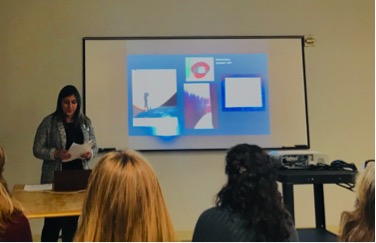Speaker: Samantha Owens, Conservation Fellow at Glenstone Museum
Talk Title: “Can’t Touch This: Incident Reporting for Visitor Interaction to Artwork”

Glenstone Museum conservation has recently implemented a new response and reporting system for visitor interaction with artwork. This past October an expansion to Glenstone opened. The museum has artwork both indoors and outdoors, and visitors are now allowed to freely roam the campus. Visitorship grew with the expansion, and the museum now allows 400 people per day. The art is on open view; there are no stanchions, tape, vitrines, or alarms. There is one staff conservator (Director of Conservation Steven O’Banion), a conservation fellow (Samantha Owens), and sometimes graduate summer interns. The galleries are staffed with guides who go through extensive training to both interpret and protect the collection. Visitors are asked not to touch the artwork upon arrival and visitor guidelines are provided on the Museum website and site maps. However, incidents inevitably occur.
Prior to the expansion, a formal report was written every time a visitor interacted with an artwork. With the exponential increase in visitorship, an alternative system needed to be devised. During the process of altering the system, Glenstone conservators met with Anouk Verbeek, who has done research on visitor interaction. She presented her work focusing on visitor interaction with the traveling Kusama show at the 2018 AIC meeting in Houston, Texas. Glenstone now has a new system for recording and responding to incidents. Incidents are recorded in a log book with varying levels of severity. For severe incidents, Conservation responds immediately. For incidents which do not result in apparent damage, Conservation checks the log and artworks the following day. Owens discussed the switch to a software system that allows for easy tracking of incidents and patterns (contact Glenstone Conservation staff for more information).
Conservation has created documents for each department with photos and instructions relevant to that department’s interaction with the artwork. For example, one document indicates how closely Facilities staff should clean to an artwork and where conservation takes over. There is also a document for Visitor Services staff, discussing points such as safe distances for guests to stand. Every time there is a new installation, the conservators lead a walkthrough to go over points of caution and answer any questions.
Integral to this system is collaboration between the various museum departments, particularly Conservation, Security, and Visitor Experience. Conservation routinely meets with members of the other departments for feedback on ways to improve and ultimately better protect the art.
Summarized by Haddon Dine, Graduate Intern at The Walters Art Museum, Third-year Graduate Fellow in the Winterthur/University of Delaware Program in Art Conservation